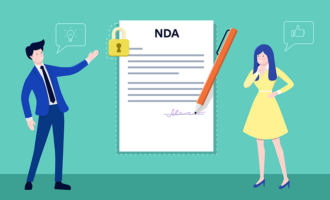When it comes to legal contracts, the verbiage you use is critical — a few wrong (or missing) words can make enforcing the contract very difficult. But before you dig too deep into the language, you first need to be sure you’re using the most appropriate legal document.
When it comes to protecting confidentiality, two common documents are the nondisclosure agreement (NDA) and the confidentiality agreement. What are the differences between them, and which one should you use? We explore this below.
Send my document for signature
File type is not allowed.
Maximum file size limit exceeded. (5MB)
Something went wrong.
Breakdown: Confidentiality agreement vs NDA
“Both NDAs and confidentiality agreements are meant to keep someone from improperly disclosing confidential information,” says Stephen Kontos, intellectual property attorney and owner of PatentXP, an intellectual property law firm.
An NDA is a contract specifically dealing with how parties will handle the others’ confidential information. A confidentiality clause is a section in a larger agreement essentially covering the same things as an NDA, only usually with less detail than in an NDA. When parties are entering into an agreement such as where one provides goods or services to the other in exchange for payment, it’s common for the parties to include confidentiality language. However, it’s also common before the parties enter into the goods or services agreement to have discussions about whether it makes sense to do business together at all.
In such cases, parties will often be exchanging confidential info as part of those discussions, so they’ll want to make sure they’re both clear on what can and can’t be done with that information. To that end, they may enter into a mutual confidentiality agreement (an NDA). Then, when and if they decide to enter into the agreement for goods or services, they’ll also include a clause in that contract further covering confidentiality obligations.
Of course, if the parties choose not to enter into the goods and services agreement, they’re still protected under the terms of the NDA they signed.
Whether the parties use an NDA or they just rely on a confidentiality clause in another agreement, their obligations of confidentiality usually continue after the underlying contract term has ended. That makes sense, because if that weren’t the case, as soon as the underlying contract term ended, the party could disclose the other party’s confidential information to anyone they wanted.
Kontos says that what you call the document is less important than its terms, especially given the overlap in the content of confidentiality agreements and NDAs. For instance, both documents might include sections requiring that confidential information be marked as such, defining who can receive confidential information, instructing the parties on how to destroy confidential documents and other materials, defining the time frame for keeping information confidential, and so on.
“That being said, there are subtle differences between the two types of documents,” Kontos explains. For example, a confidentiality agreement might define ownership of any intellectual property resulting from the collaboration. “If you’re using an NDA, however, the question of intellectual property ownership has most likely already been settled.”
When to use NDAs and confidentiality agreements
As for the name of the confidentiality agreement, Kontos says that NDAs are often used by inventors who are trying to maintain confidentiality before formally protecting their rights with a patent application. A public disclosure of a patentable concept can waive patent rights in the United States and elsewhere.
“An NDA is a common tool used to prevent such an occurrence until the inventor is able to file a patent application,” Kontos explains.
Also, a business might require new employees to sign NDAs as a condition of employment to protect confidential business information and trade secrets. Here are some examples:
- A restaurant may require employees to sign an NDA before it discloses award-winning recipes to cooks.
- A tech startup may require employees to sign an NDA to protect proprietary software code and algorithms.
- A manufacturer may require employees to sign an NDA to safeguard unique fabrication processes that result in industry-leading cost efficiencies.
- A marketing firm may require employees to sign an NDA to prevent their client contact list and service fees from leaking to competitors.
“Confidentiality agreements are common at the start of a joint venture or other business arrangement where both parties are likely to exchange confidential information,” Kontos says.
For example, you typically see confidentiality agreements used between an original equipment manufacturer (OEM) and a supplier. The confidentiality agreement permits the OEM to provide confidential specifications to the supplier and the supplier to disclose details about its proprietary manufacturing process to the OEM. Both parties are disclosing information that, if leaked, could be detrimental to their businesses.
Whether you’re a small business owner or run a department in a larger company, both confidentiality agreements and NDAs are essential to keeping your organization’s sensitive or proprietary information safe.
Want the full rundown on NDAs? Check out this complete guide on the topic.

Business photo created by katemangostar – www.freepik.com
AS ALWAYS, CONSULT AN ATTORNEY BEFORE RELYING ON ANY FORM CONTRACT OR CONTRACT TEMPLATE. THE CONTENT ABOVE IS FOR INFORMATIONAL PURPOSES ONLY.









Send Comment: